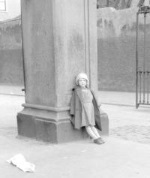Mellows Bridge Historian In Residence Blog
Published on 28th August 2018
 Mellows bridge, situated towards the Heuston Station end of the quays, sits on the site of one of the oldest bridges in Dublin city. The original was built in 1688, was named Arran bridge and it collapsed in 1763. Its replacement, completed in 1768, was known as the Queen’s Bridge and has been renovated several times since. In the post-independence rush to rebrand structures with imperial connections, the Dublin Municipal Council renamed the bridge after Queen Maeve of Connacht in 1922.
Mellows bridge, situated towards the Heuston Station end of the quays, sits on the site of one of the oldest bridges in Dublin city. The original was built in 1688, was named Arran bridge and it collapsed in 1763. Its replacement, completed in 1768, was known as the Queen’s Bridge and has been renovated several times since. In the post-independence rush to rebrand structures with imperial connections, the Dublin Municipal Council renamed the bridge after Queen Maeve of Connacht in 1922.
In 1942, the National Graves Association successfully petitioned to change the name to Mellows bridge, marking both the death of Barney Mellows in February 1942 and the 20th anniversary of the execution of his brother Liam. Born in Manchester in 1892, William Mellows was the son of a British army sergeant and his family moved to Ireland in the early 1900s. He attended the Hibernian Military School in Dublin but soon both Mellows brothers became heavily involved in the republican movement, starting with Na Fianna, before graduating to the Volunteers and the IRB. William soon abandoned his first name, choosing the more appropriately Gaelic Liam, and lead the Galway Volunteers during the 1916 Rising. After returning from the US in 1920, he chose the anti-Treaty side and was captured in the Four Courts in June 1922. While being held in Mountjoy Prison he was appointed Minister for Defence in de Valera’s shadow cabinet but was one of four prisoners executed in reprisal for the killing of TD Sean Hales in December 1922. On 25 May 1942, following a procession from St Stephen’s Green, members of the National Graves Association and the Old Fianna Association assembled to hear a speech from Nora Connolly, daughter of James. Connolly pointedly remarked that Mellows’ vision of Irish independence was freedom from ‘foreign oppression and domestic exploitation’. A plaque was also unveiled on the bridge, dedicated to ‘Liet-General Liam Mellows’, reflecting his high status in the republican movement. Mellows bridge remains the oldest bridge over the Liffey and commemorates one of the most fascinating characters of the revolutionary period in Ireland.
Bernard Kelly, Historian in Residence, Dublin City Library and Archive.
Dublin City Council Historians in Residence are available to meet groups and schools, give talks, walks etc, run history book clubs and advise on historical research.